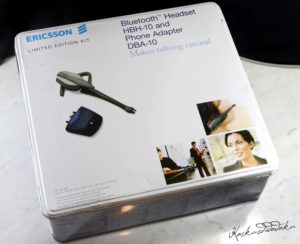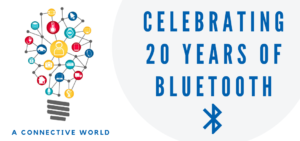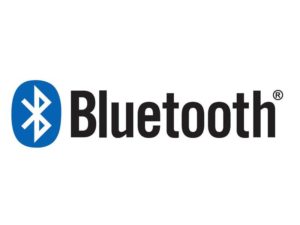
Two decades ago, in 1998, the concept of Bluetooth was born, and little did we realise that this oddly named wireless technology would rapidly become one of the greatest technology enablers of all time.
When the first commercial products started to roll out at the turn of the millennium, I was working at Orange creating training material for the network’s third party retailers and Bluetooth was, like WAP and Wildfire one of many exciting new developments that we hoped to enthuse the channel about. I was lucky to receive from Ericsson a limited edition Bluetooth kit containing a HBH-10 headset and adapter to enable my T28 to hook up to it.
However, despite being impressed at how clever it all was, I was just too self-conscious to go full geek and use it in public! And whilst those behind the technology probably had a vision for where it could lead, I certainly didn’t think far beyond the wireless Bluetooth headset…how wrong was I?

If you don’t know the history behind the development of Bluetooth it’s incredibly interesting. The germ of the idea was first pioneered more than half a century before its official launch. Like so many technological breakthroughs, war proved the catalyst. The pioneer was Hollywood actress and part time inventor Hedy Lamarr.
Her war-time invention was for radio communications to ‘hop’ from one frequency to another, so that Allied torpedoes couldn’t be detected by the enemy. Despite not being able to bring it to market, her idea paved the way for both Bluetooth and Wifi.
Fast forward to 1989 and a meeting between Nils Rydbeck, CTO at Ericsson Mobile in Lund, Sweden and Johan Ullman paved the way for the realisation of Lamarr’s vision. The meeting was to establish a mobile specific solution for hands-free headsets.
The development of the “short-link” radio technology, uniting the PC and cellular industries, later named Bluetooth, was initiated in December 1996 where a series of companies got together to form the Bluetooth Special Interest Group (SIG), finally established in 1998.

What the companies (thankfully) understood was that a standardized protocol had to be created so that Bluetooth would seamlessly work across several devices from a multitude of companies. SIG, which started with five companies (Ericsson, Intel, Nokia, IBM, and Toshiba) and 400 members now has more than 30,000.
Most of us don’t think about whether a product is Bluetooth enabled we just expect it to be built inallowing our smartphones to connect seamlessly to all manner of devices such as headphones, wireless speakers and voice enabled assistants.
Eighty Six per cent of new vehicles now come with integrated Bluetooth, allowing drivers to enjoy their personal streaming services such as Spotify and helping to reduce the number of motorists spotted with a mobile phone clamped to their ear. Without Bluetooth there wouldn’t be voice control in Sky Q remotes, wireless gaming controllers, PC connectivity and devices and whole new categories such as Wearable technology.

It is a great democratising force in technology. And what about the future? The SIG’s Developer Centre provides the opportunity for companies and individuals to create Bluetooth products and take them to market. A whole host of exciting developments are powering new possibilities for the technology.
- Point-to-point is a network topology used for establishing one-to-one (1:1) device communications. This enables all your devices to talk to each other. It provides optimized data transfers and is ideal for connected device products, such as fitness trackers and health monitors.
- Meanwhile Mesh is a network topology used for establishing many-to-many device communications. The mesh system enables the creation of large-scale device networks with the ability to connect thousands of devices reliably and securely communicating with one another.

In retail this presents some great opportunities. With traditional retail under enormous pressure, pioneering retailers are already leveraging Bluetooth to enable personalised promotions and way-finding services that connect to smart shelves. Increased customer-centricity enabled by Bluetooth could include Smart pricing, tailored offers, real time data-led category management, all the while creating better shopper experiences for the customer. This in turn will enable retailers to increase sales, boost profit and reduce operating costs.
Bluetooth can play a vital role in enabling planners to connect city infrastructures in ways never before imagined and gather data to guide informed policy making. As the population grows exponentially, there will be increased pressure on resources, utilities, and council budgets. Smart homes and cities can provide ongoing real time feedback to provide evidence-based decisions based on human need. From where to plan schools, doctors’ surgeries or free bike stations.
As the demands of the Internet of Things (IoT) continue to grow, Bluetooth continues to expand its capabilities. This most strangely named of technologies is set to remain an ongoing but invisible feature in all our lives. Happy birthday Bluetooth! My haven’t you grown.
Article By Rupert Cook, Business Development Director, Gekko.

About Rupert:
Rupert has worked in marketing for technology brands for over 20 years and is now Business Development Director at Gekko.
Gekko is a marketing agency, specialised in connecting brands with consumers in retail throughout the UK and Ireland. Gekko are experts in delivering, results-driven BTL solutions for Technology and Leisure brands helping to create more opportunities to connect consumers with their products.
Services include merchandising, in-store promoters, mystery shopping, training, and experiential as well as strategic field teams and e-retail compliance.
Source: Gekko

You must be logged in to post a comment Login